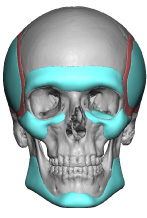
Most custom facial implants cause a great deal of swelling.What is unique about most custom facial implants is that they are usually larger in size and, as a result, involve more tissue dissection to be placed. While the entry incision(s) may be small, the internal area dissected is much larger. This usually creates a significant amount of tissue swelling and facial distortion. It is almost always much more than any patient can anticipate. No matter how much you think it can swell and cause the image you see in the mirror to become almost unrecognizable, it will likely be even more so.
The swelling phase is both predictable and prolonged. Facial swelling after implant placement follows a predictable postoperative course. It will take at least two days for the peak of the swelling to occur. While you may feel as though you might not look too badly the day after surgery… more swelling is yet to come. Once the swelling has peaked, it will go down on a decreasing percent resolution over the next six to eight weeks. At ten days, 50% of the swelling will be gone, two-thirds to 75% by three weeks and about 90% by six weeks after surgery. This postoperative course indicates that it will take several months following surgery to truly see the final results of your custom facial implant procedure. Any judgment beforehand would be premature.
The recovery process can be very stressful. While the swelling and the course of its resolution is explained in detail before surgery, managing it can be very different from understanding it. Many patients go through a difficult and psychologically distressing period after surgery. Viewing your own face while it is distorted during recovery is very challenging versus what is revealed during the implant design process in the 3-D planning pictures prior to surgery. This can make some patients concerned that something has gone wrong or they have chosen an incorrect the implant design(s). It is very important to expect this period of adjustment and stress to happen after surgery, and to understand that recovery is a process. What you see in the mirror just days or weeks after surgery is not the final result.
Evaluating the final results from custom facial implant surgery takes time. Because facial recovery can be very psychologically disturbing, some patients think about changing the implant design or even removing implants in the first month after surgery. Such decisions are completely premature and are emotionally based rather than logical. It is important that one persist through the full extent of the recovery process until the final results of surgery are visible three to six months following the procedure.

Dr. Barry Eppley
Indianapolis, Indiana


